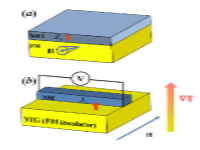Pure Spin and Magnonic Current Control
The main focus is on the exploration of more efficient generation and detection of pure spin currents in metals and insulators and more efficient spin current-driven magnetization dynamics in both magnetic metal and insulator devices.
Pure spin current can be generated in several ways, e.g. by spin pumping (Fig. 1(a)), heat (Fig. 1(b)), or spin Hall effect. In a non-magnetic material, the pure spin current, Js, decays over a characteristic length called spin diffusion length ranging from ~1 nm to microns. Js can be converted to an electric field or voltage by a heavy metal such as Pt or Au with strong spin-orbit coupling. One important but poorly experimentally determined parameter that affects the efficiency of both generation and detection of Js is the spin Hall angle. Chien and M.Z. Wu will work on various material structures and experimental techniques such as ferromagnetic resonance and longitudinal spin Seebeck effect to more precisely determine the spin Hall angle by excluding other extrinsic factors. With the theoretical support from R.Q. Wu, the team aims to develop a better understanding of spin current transport phenomena in thin films and heterostructures.
